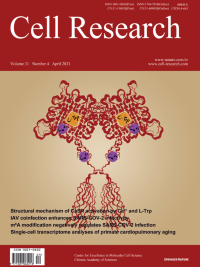
Advanced Search
Submit Manuscript
Advanced Search
Submit Manuscript
Volume 31, No 4, Apr 2021
ISSN: 1001-0602
EISSN: 1748-7838 2018
impact factor 17.848*
(Clarivate Analytics, 2019)
Volume 31 Issue 4, April 2021: 478-481 |
Aldolase is a sensor for both low and high glucose, linking to AMPK and mTORC1
Mengqi Li1 , Chen-Song Zhang1 , Jin-Wei Feng1 , Xiaoyan Wei1 , Cixiong Zhang1 , Changchuan Xie1 , Yaying Wu1 , Simon A. Hawley2 , Abdelmadjid Atrih3 , Douglas J. Lamont3 , Zhichao Wang4 , Hai-Long Piao5 , D. Grahame Hardie2 , Sheng-Cai Lin1,*
1State Key Laboratory for Cellular Stress Biology, School of Life Sciences, Xiamen University, Xiamen, Fujian 361102, ChinaDear Editor,
As well as glucose being the major carbon nutrient for most cells, its availability also acts as a gate-keeper exerting a switch between anabolic and catabolic metabolism, with the protein kinases mTORC1 and AMP-activated protein kinase (AMPK) being the two master controllers.1 In low glucose, AMPK is activated and phosphorylates a wide range of downstream targets to maintain energy homeostasis, by switching on catabolic pathways while switching off ATP-consuming processes.1 In high glucose, mTORC1 is activated and shifts the metabolic program of the cell towards anabolic metabolism.1 It is already known that low glucose, and hence low levels of the glycolytic intermediate fructose-1,6-bisphosphate (FBP), can be sensed by aldolase to trigger AMPK activation via the lysosomal pathway.2,3 This occurs independently of increases in AMP and ADP, the classical activators of AMPK.2 Although it is clear that mTORC1 is also regulated by glucose availability at multiple levels, the underlying mechanisms have not been fully elucidated.
https://doi.org/10.1038/s41422-020-00456-8